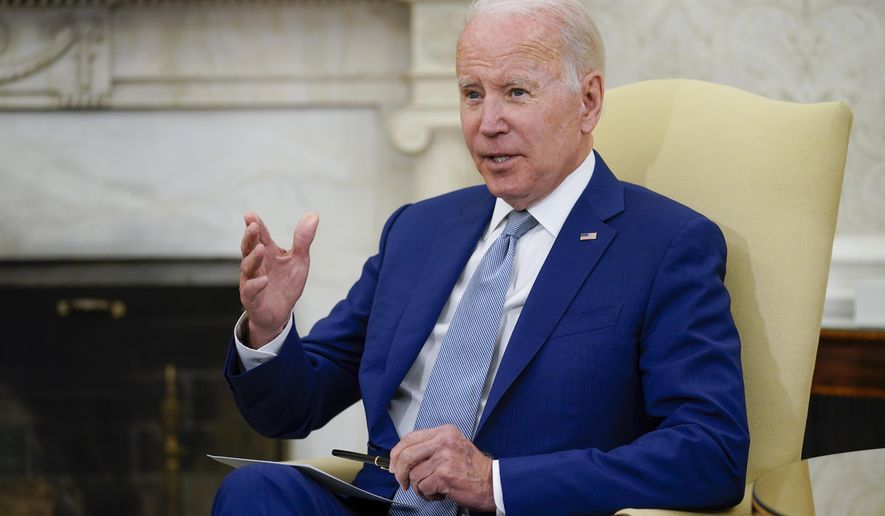President Biden dismissed Russia’s doomsday saber-rattling, saying U.S. officials see no indication Moscow is intent on resorting to nuclear weapons in its assault on Ukraine.
Russian officials appear increasingly agitated at the flow of U.S. and Western arms to Kyiv, including a new $700 million package the Pentagon confirmed Wednesday, saying the weapons could be used to strike inside Russia and may spark a wider conflict.
The Biden administration is “deliberately and diligently pouring fuel on the fire,” Kremlin spokesperson Dmitry Peskov told reporters in Moscow Wednesday, adding that Russian military leaders do not trust Kyiv’s assurances that the multiple long-range rocket systems supplied by Washington will only be used for defensive purposes inside Ukraine.
But Mr. Biden, in an op-ed in The New York Times published Wednesday, pointedly dismissed threats from some voices in the regime of President Vladimir Putin that NATO risked a nuclear escalation if it continued to arm Ukraine in the fighting.
“I know many people around the world are concerned about the use of nuclear weapons,” Mr. Biden wrote. “We currently see no indication that Russia has intent to use nuclear weapons in Ukraine, though Russia’s occasional rhetoric to rattle the nuclear saber is itself dangerous and extremely irresponsible.”
Mr. Biden said Moscow would face “severe consequences” should it employ nuclear weapons “on any scale.”
SEE ALSO: Russia batters key city in eastern Ukraine, controls at least half
Pentagon officials Wednesday confirmed the U.S. will send Ukraine rocket launchers capable of striking Russian targets at more than twice the range of the M777 howitzers that have already been deployed to the battlefield.
The M142 High Mobility Artillery Rocket System (HIMARS) is a lighter and more agile wheel-mounted version of the tracked M270 Multiple Launch Rocket System. They will be part of the latest $700 million drawdown of U.S. military stock ordered by Mr. Biden just days after Congress approved on a bipartisan basis a $40 billion package of military, economic and humanitarian support for Ukraine.
In addition to the four HIMARS rocket systems, Ukraine will receive four Mi-17 helicopters; seven counter-artillery and air surveillance radar systems; 15,000 155mm artillery rounds; 6,000 anti-armor weapons; and 15 tactical vehicles among other military hardware.
“Right now, it’s a concentrated artillery duel in the east,” Colin H. Kahl, undersecretary of defense for policy, told reporters at the Pentagon.
Ukrainians are assuring Washington the HIMARS rockets will be used for “defensive purposes only,” even as top Kremlin officials are decrying the shipment as a direct threat to their security.
Western leaders have walked a fine line in providing lethal aid to Ukraine over concerns for further escalating the conflict and fear of being drawn into direct war with nuclear-armed Russia.
SEE ALSO: Russian lawmaker boasts that just two of Putin’s Satan 2 missiles can destroy U.S. coasts
Moscow has on multiple occasions issued veiled threats that it was willing to use its vast nuclear arsenal since invading Ukraine.
Russian President Vladimir Putin placed Russia’s nuclear forces on heightened alert in late February in response to “unfriendly economic actions” and “aggressive statements” from Western countries just days after the war began and senior Russian officials have made subsequent threats as the war has dragged on.
On Tuesday, a hawkish pro-Putin Russian lawmaker threatened on state TV that Russia’s military could destroy “the entire East Coast of the U.S.”
“Four missiles and there’ll be nothing left,” Alexei Zhuravlev said. “They think the mushroom cloud will be taller than a high rise. That mushroom cloud will be visible from Mexico.”
U.S. intelligence officials have warned that Mr. Putin has become more unpredictable as the war in Ukraine has not unfolded according to the Kremlin’s original plans, but the Russian leader’s threats have shown little sign of deterring U.S. and allied weapons shipments to Ukraine.
The decision to send the medium-range rockets strikes a balance between the howitzers the U.S. previously provided and the longer-range rockets, which have a range of close to 200 miles and that American officials say could further escalate tensions between the U.S. and Russia.
The U.S. has provided a total of $4.5 billion in lethal aid to Ukraine since the end of February.
The four HIMARS launchers were already based in Europe when they were added to the list for Ukraine. It will likely take about three weeks to train the Ukraine soldiers on the system as well as the maintenance needs.
“Russia doesn’t get a veto over what we send to the Ukrainians. [They] didn’t start this war — the Russians did,” Mr. Kahl said. “This war was unprovoked. The Russians can end this conflict anytime they want.”
Mr. Biden said the aim of sending lethal assistance to Ukraine is not to prolong the war or to inflict pain on Russia, but said the U.S. stands ready to continue arming Kyiv as the war drags on. He also said that while the U.S. supports a diplomatic end to the war, it must be on Ukraine’s terms and Washington will not pressure the Kyiv government to make any territorial concessions.
• Joseph Clark can be reached at jclark@washingtontimes.com.
• Mike Glenn can be reached at mglenn@washingtontimes.com.




Please read our comment policy before commenting.